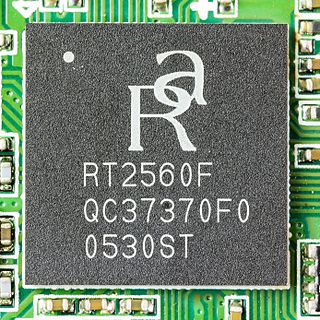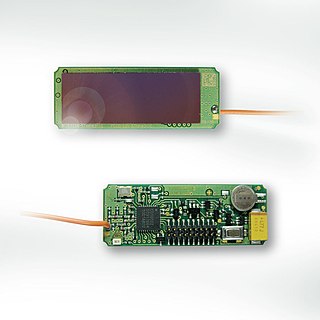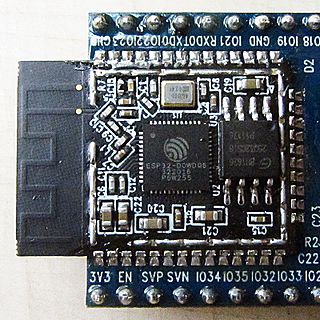| Manufacturer | Module | SOC/SIP Chip | MCU core | RAM | Flash | Antenna | Sleep | TX | RX | TX Power | Sensitivity | PCB Size | Released | Interfacing | Firmware options |
|---|
| Anaren | A2530R24A
| CC2530 [13] | 32 MHz
8-bit 8051 | 8 kB | 256 kB | Printed Trace | 1 μA | 34 mA | 25 mA | 4 dBm | -90 dBm | 11 mm × 19 mm | July, 2012 | UART,
SPI | AIR-ZNP, based on TI Z-Stack |
| A2530R24C | U.FL connector |
| A2530E24A | Printed Trace | 130 mA | 28 mA | 15 dBm | -95 dBm |
| A2530E24C | U.FL connector | 106 mA | 28 mA | 13 dBm | -95 dBm |
| Atmel | ZigBit 2.4 GHz
(ATZB-24-B0) | AT86RF230 | 8-bit
ATmega
1281v | 8 kB | 128 kB | RF output | < 6 μA | 18 mA | 19 mA | -17 dBm
to
3 dBm | -101 dBm | 18.8 mm × 13.5 mm × 2.0 mm | 2009 | UART,
USART,
SPI,
I²C,
JTAG | BitCloud - Zigbee PRO,
Wireless MCU Software,
BitCloud stack,
SerialNet,
OpenMAC |
ZigBit 2.4 GHz
(ATZB-24-A2) | balanced dual chip antenna | 24 mm × 13.5 mm × 2.0 mm |
ZigBit 2.4 GHz Amplified
(ATZB-A24-U0) | RF output | 50 mA | 23 mA | Up to
20 dBm | -104 dBm | 38 mm × 13.5 mm × 2.0 mm |
ZigBit 2.4 GHz Amplified
(ATZB-A24-UFL) | U.FL connector |
ZigBit 700/800/900 MHz
(ATZB-900-B0) | AT86RF212 | RF output | 26 mA | 11 mA | Up to
11 dBm | –110 dBm | 24 mm × 13.5 mm × 2.8 mm |
| California Eastern Laboratories | ZICM357SP2 | EM357 [14] [15] | 32 bit,
ARM Cortex
-M3 | 12 kB | 192 kB | PCB Trace Antenna or RF Port for External Antenna | 1 μA | 58 mA | 34 mA | 20 dBm | –103 dBm | 23.9 mm × 16.6 mm | Apr, 2012 | UART,
SPI,
TWI | Zigbee PRO stack: EmberZNet PRO |
| ZICM357SP0 | EM357 [16] [17] | 32 bit,
ARM Cortex
-M3 | 12 kB | 192 kB | PCB Trace Antenna or RF Port for External Antenna | 1 μA | 31 mA | 30 mA | 8 dBm | –100 dBm | 23.9 mm × 16.6 mm | Apr, 2012 | UART,
SPI,
TWI | Zigbee PRO stack: EmberZNet PRO |
| ZICM3588SP0 | SiLabs EM3588 [18] | 32 bit,
ARM Cortex
-M3 | 64 kB | 512 kB | PCB Trace Antenna or U.FL connector | 2.4 μA | 44 mA | 30 mA | 8 dBm | –100 dBm | 23.9 mm × 16.6 mm | Mar, 2014 | UART,
SPI,
I²S | CEL Zigbee Stack
Synapse SNAP Stack |
| Digi International | Series 1 XBee [19] | Freescale MC13193 [20] | 8-bit 689S08A HCS08 | 4 kB | 60 kB | integrated Whip, chip or U.FL connector, RPSMA connector | 10 μA, 50 μA | 45 mA | 50 mA | 0 dBm | –92 dBm | 24.38 mm × 27.61 mm | Dec, 2006 [21] | UART | Zigbee stack [22] |
| Series 1 XBee-PRO [23] | 250 mA, 340 mA, 180 mA | 55 mA | 18 dBm,
10 dBm | –100 dBm | 24.38 mm × 32.94 mm |
| Series 2 XBee ZB [24] | Ember (now Silicon Labs) EM250 [25] [26] | 16-bit
12 MHz
RISC | 5 kB | 128 kB | 1 μA | 40 mA, 35 mA | 40 mA, 38 mA | 3 dBm,
1 dBm | –96 dBm,
–95 dBm | 24.38 mm × 27.61 mm | Apr, 2008 [27] | Ember ZNet [28] |
| Series 2 XBee-PRO ZB [29] | 10 μA | 295 mA, 170 mA | 45 mA | 17 dBm,
10 dBm | –102 dBm | 24.38 mm × 32.94 mm |
| Dresden elektronik | deRFmega128-22M00 2.4 GHz | ATmega128RFA1 | 8-bit
ATmega | 16 kB | 128 kB | Chip ceramic antenna | < 1 μA | 18 mA | 18 mA | +3 dBm | -98 dBm | 23.6 mm × 13.2 mm × 3.0 mm | 2012 | JTAG, UART,
I²C,
ADC,
SPI,
GPIO | MAC stack
Zigbee (BitCloud)
6LoWPAN
Atmel |
| deRFmega128-22M10 2.4 GHz | RF pads | 19.0 mm × 13.2 mm × 3.0 mm |
| deRFmega128-22M12 2.4 GHz | 198 mA | 22 mA | +22 dBm | –105 dBm | 21.5 mm × 13.2 mm × 3.0 mm |
| deRFmega256-23M00 2.4 GHz | ATmega256RFR2 | 8-bit
ATmega | 32 kB | 256 kB | Chip ceramic antenna | < 1 μA | 19 mA | 11 mA | +3.5 dBm | -98 dBm | 23.6 mm × 13.2 mm × 3.0 mm | 2013 | JTAG, UART,
I²C,
ADC,
SPI,
GPIO |
| deRFmega256-23M10 2.4 GHz | RF pads | 19.0 mm × 13.2 mm × 3.0 mm |
| deRFmega256-23M12 2.4 GHz | 233 mA | 17 mA | 23 dBm | –104 dBm | 21.5 mm × 13.2 mm × 3.0 mm |
| deRFsam3-23M10-2 2.4 GHz | ATSAM3S4A [30]
AT86RF232 [31] | 32-bit
ARM Cortex
-M3 | 48 kB | 256 kB | RF pads | < 6 μA | 45 mA | 41 mA | +3 dBm | -100 dBm | 21.5 mm × 13.2 mm × 3.0 mm | JTAG, UART,
I²C,
ADC,
SPI,
GPIO,
USB |
| deRFsam3-13M10 868, 915 MHz | ATSAM3S4A [32]
AT86RF212 [33] | 50 mA | 37 mA | +5 or +10 dBm | –110 dBm | 21.5 mm × 13.2 mm × 3.0 mm | JTAG,
UART,
I²C,
ADC,
SPI,
GPIO,
USB |
deRFusb-23E00 2.4 GHz
deRFusb-23E06 2.4 GHz | ATSAM3S4B [34]
AT86RF231 [35] | 32-bit
ARM Cortex
-M3 | 48 kB | 256 kB | Chip ceramic antenna | 32 mA | 51 mA | 45 mA | +3 dBm | -97 dBm | 71.0 mm × 23.0 mm × 8.7 mm | 2012 | USB, optional: JTAG, Debug |
deRFusb-23E00 JTAG 2.4 GHz
deRFusb-23E06 JTAG 2.4 GHz | 63.5 mm × 19.0 mm × 9.5 mm | USB, JTAG, Debug |
deRFusb-13E00 868, 915 MHz
deRFusb-13E06 868, 915 MHz | ATSAM3S4B [36] br> AT86RF212 [37] | +9 dBm | -106 dBm | 71.0 mm × 23.0 mm × 8.7 mm | USB, optional: JTAG, Debug |
deRFusb-13E00 JTAG 868, 915 MHz
deRFusb-13E06 JTAG 868, 915 MHz | 63.5 mm × 19.0 mm × 9.5 mm | USB, JTAG, Debug |
Embit | EMB-WMB169PA, 169 MHz [38] [39] [40] | MSP430F534x [41] | 16 bit MSP430 | 10 kB / 8 kB / 6 kB | 128 kB / 96 kB / 64 kB | RF Pads, U.FL Connector | <2 μA | 57 mA@
+15dBm | 27 mA (full sens.) | up to
30 dBm | -122 dBm | 29 mm × 22 mm | 2012 | UART,
SPI,
JTAG | MSP430F534x [42] |
| EMB-WMB868, 868 MHz [43] [44] [45] | MSP430F534x [46] | 16 bit MSP430 | 10 kB / 8 kB / 6 kB | 128 kB / 96 kB / 64 kB | RF Pads, U.FL Connector | <2 μA | 57 mA@ +15dBm | 27 mA (full sens.) | 15 dBm | -122 dBm | 29 mm × 22 mm | 2012 | UART,
SPI,
JTAG | Wireless M-Bus stack [47] |
| EMB-Z2530PA, 2.4 GHz [48] [49] [50] | CC2530 [51] | 8 bit 8051 | 8 kB | 256 kB | PCB Antenna, U.FL Connector, Wire Antenna opt | <1.1 μA | 135 mA@ +20dBm | 28 mA | 20 dBm | -100 dBm | 29 mm × 22 mm | 2011 | UART,
SPI,
JTAG | TIMAC (IEEE 802.15.4), [52] ZStack (Zigbee) [53] |
| EMB-ZRF212B, 868 MHz, 915 MHz [54] [55] [56] | ATxmega128D3 [57] | 8/16 bit AVR XMEGA | 8 kB | 128 kB | Ceramic Antenna, U.FL Connector, RF pads | 1.3 μA | 17 mA@ +5dBm | 10 mA | 10 dBm | –110 dBm | 29 mm × 22 mm | 2013 | UART,
SPI,
JTAG | Atmel Lightweight Mesh, [58]
Atmel MAC (IEEE 802.15.4), [59]
Atmel BitCloud (Zigbee PRO) |
| EMB-ZRF231PA, 2.4 GHz [60] [61] [62] | ATxmega256A3U [63] | 8/16 bit AVR XMEGA | 16 kB | 256 kB | PCB Antenna, U.FL Connector, RF pads | <1.1 μA | 132 mA@ +20dBm | 24 mA | 20 dBm | -105 dBm | 29 mm x 22 mm | 2011 | UART,
SPI,
JTAG | Atmel Lightweight Mesh, [64]
[Atmel MAC (IEEE 802.15.4), [65]
Atmel BitCloud (Zigbee PRO) |
| FlexiPanel Ltd | Pixie [66] [67] | Texas Instruments CC2420 [68] [69] | PIC18LF4620 | 4 kB | 64 kB | integral | 2 μA | 25 mA | 0 dBm | | | Mar, 2008 | UART,
SPI | Microchip Zigbee |
| Pixie Lite [70] [71] | PIC18LF2520 | 1.5 kB | 32 kB |
| Kirale Technologies | KTWM102-11 | Microchip ATSAMR21E19A | 32-bit
ARM Cortex -M0+ | 32 kB | 256 kB
+
512 kB | on-board chip | 5 μA | 17 mA | 19 mA | 4 dBm | -104 dBm | 16.6 mm × 11.4 mm × 2.2 mm | 2018 | UART,
USB,
JTAG | KiNOS Thread Certified Stack [72]
Atmel |
| KTWM102-21 | W.FL connector |
| MMB Networks | Z357PA40 | Ember (now Silicon Labs) EM357 [73] | 32-bit
ARM Cortex
M3 | 12 kB | 192 kB on-chip, 512 kB on-board | U.FL, on-board chip ceramic | 0.65 μA | 175 mA at 20 dBm TX power | 32 mA | 20 dBm max.,
software programmable | -106 dBm | 34.2 mm × 15 mm × 2.88 mm | 2015 | UART and
SPI | Ember's (now Silicon Labs')
EmberZNetPRO [74] with MMB's
RapidConnect family of firmware |
| NXP | JN5168-001-M00 [75] | JN5168 | 32 MHz
32-bit
RISC | 32 kB | 256 kB | on board | 0.15 μA | 15 mA | 17 mA | 2.5 dBm | -95 dBm | 16 mm × 30 mm | 2013 | UART,
SPI | JenNet stack
Zigbee stack |
| JN5168-001-M03 [76] | U.FL connector |
| JN5168-001-M05 [77] | U.FL connector | 35 mA | 22 mA | 9.5 dBm | -96 dBm | 16 mm x30 mm |
| JN5168-001-M06 [78] | U.FL connector | 175 mA | 22 mA | 22 dBm | -100 dBm |
| Control Data Systems | VersaNode 210 [79] | MC13224V | 32-bit ARM7 | 96 kB | 128 kB | MMCX Connector | 15 μA | 60 mA | 21 mA | 10 dBm | -98 dBm | 20 mm × 25 mm | 2009 | UART,
SPI | Control Data Systems ISA100.11a |
| Panasonic | PAN4555 | MC1321x | 8-bit MC9S08GT HC08 | 4 kB | 60 kB | RF out or ceramic antenna | 0.25 μA, 1.9 μA, 36 μA, 1.6 mA | 36.5 mA | 37 mA | –4 dBm,
0 dBm | –92 dBm | 12.2 mm × 16.4 mm × 2.2 mm | 2008 | UART,
SPI | Freescale Beestack
[Synapse SNAP Stack |
| PAN4561 | MC13213 | SMD RF out, ceramic antenna or U.FL | 1.6 mA, 50 μA, 16 μA, 2 μA | 202 mA | 45 mA | 20 dBm | –105 dBm | 35 mm × 15 mm | Jan, 2009 | UART,
I²C |
| PAN4570 [80] | Ember (now Silicon Labs) EM250 [81] [82] | 16-bit 12 MHz
RISC | 5 kB | 128 kB | 1 μA, 1.5 μA | 35.5 mA, 41.5 mA, 28 mA | 35.5 mA, 37.5 mA | 3 dBm,
5 dBm,
–32 dBm | –97 dBm | 26.5 mm × 20 mm × 2.8 mm | 2006 | UART,
SPI,
I²C | Ember (now Silicon Labs) EM250 [83] |
| Radiocrafts | RC2200 [84] | Texas Instruments CC2420 [85] [86] | 8-bit
ATmega128 | 4 kB | 128 kB | integrated, MMCX connector or RF on pin connector | 23 μA, 1.3 μA | 27 mA | 30 mA | 0 dBm | -94 dBm | 16.5 mm × 29.2 mm × 3.5 mm | 2008 | UART,
SPI,
JTAG,
ISP | Texas Instruments Z-stack [87]
or any third-party
Zigbee stack |
| RC2201 [88] | 8 kB | 1.3 μA |
| RC2202 [89] | 2 kB | 32 kB | 23 mA | 26 mA |
| RC2204 [90] | 4 kB | 64 kB | 23 μA, 1.3 μA | 27 mA | 30 mA |
| RC2201HP [91] | 8-bit
ATmega1281 | 8 kB | 128 kB | integrated or RF-on-pin connector | 40 μA, 2 μA | 140 mA | 28 mA | 17 dBm | -92 dBm | 16.5 mm × 35.6 mm × 3.5 mm | Jan 2008 [92] |
| RC2300 [93] | Texas Instruments CC2430
(CC2431
for location
engine option) [94] [95] | 8-bit 8051 | 300 μA, 0.9 μA, 0.6 μA | 27 mA | 27 mA | 0 dBm | 12.7 mm × 25.4 mm × 2.5 mm | Jul 2008 [96] | UART,
SPI,
proprietary serial
debugging interface |
| RC2301 [97] |
| RC2302 [98] | 32 kB |
| RC2304 [99] | 64 kB |
| Monolithics | ZMN2405 | Texas Instruments CC2430 [100]
[101] | 8-bit 8051 | 8 kB | 128 kB | RFIO pad | 3 μA | 28 mA | 27 mA | 0 dBm | -92 dBm | 30.5 mm × 21.2 mm | 2008 | UART,
SPI, | Zigbee stack, RFM's CSM standard module application profile |
| ZMN2430 | 25 mm × 20.3 mm |
| ZMN2430A < | built-in | –2 dBm | –90 dBm | 25 mm × 26.9 mm |
| ZMN2405HP | RFIO pad | 130 mA | 33 mA | 17 dBm | -95 dBm | 40.6 mm × 21.2 mm |
| ZMN2405HPA | built-in | 15 dBm | 47 mm × 21.2 mm |
| ZMN2430HP | RFIO pad | 17 dBm | 30.48 mm × 25 mm |
| ZMN2430HPA | built-in | 15 dBm | 36.83 mm × 25 mm |
| Radios, Inc. | MXR-EM20 [102] | Ember 2420 [103] | 8-bit
ATmega128L | 4 kB | 128 kB | RF on pin | 20 μA | 17.4 mA | 19.7 mA | 0 dBm | –94 dBm | 25.4 mm × 18.4 mm | Oct
2005 | SPI | Zigbee stack |
| Synapse | SM220UF1 [104] | ATmega128RFA1 | 8-bit
ATmega | 16 kB | 128 kB | PCB Antenna and U.FL connector | 0.4 μA | 20 dBm: 150 mA 6 dBm: 55 mA | 22 mA | 20 dBm | –103 dBm | 29.8mm × 19mm | 2013 | UART,
SPI,
I²C | Synapse SNAP Stack |
| [Talon Communications | Oasis [105] [106] | NXP
(formerly Freescale) KW22D512V | Cortex-M4 | 64 kB | 512 kB | U.FL, MMCX or edge connect to external trace PIFA | 4uA | 111 mA | 24 mA | 20 dBm | -108 dBm | 25mm × 20mm × 2.7mm | Feb
2015 | JTAG,
UART,
I²C,
ADC,
SPI,
GPIO,
PWM,
USB | SMAC |
| Sierra mangOH IoT [107] | RP-SMA, Chip | 45mm × 22.3mm × 2.7mm | May 2016 | JTAG,
UART,
SPI,
GPIO,
USB |
| Telegesis Ltd | ETRX2 | Ember
(now Silicon Labs)
EM250 [108] [109] | 16-bit 12 MHz
RISC | 5 kB | 128 kB | integrated, U.FL connector or 50Ω pad | 1 μA, 1.5 μA | 35.5 mA, 41.5 mA, 28 mA | 35.5 mA, 37.5 mA | 3 dBm,
5 dBm | −94 dBm,
−95 dBm,
−98 dBm,
−99 dBm | 37.75 mm × 20.45 mm | 2008 | SIF,
UART,
I²C,
SPI | Ember ZNet Stack [110] |
| ETRX2-PA | 0.8 μA, 1.5 μA, 3 μA, 3.5 μA | 56 mA, 63 mA, 106 mA, 120 mA, 121 mA | 37 mA | 0 dBm,
10 dBm, 18.5 dBm,
17.5 dBm | −92 dBm,
−93 dBm,
−96 dBm,
−97 dBm | 37.75 mm × 20.5 mm | 2009 |
| ETRX2USB | integrated | 32 mA, 27 mA, 26 mA | 55 mA, 62 mA | 62 mA | 3 dBm,
18 dBm | | | 2008 | SIF |
| ETRX351 | Silicon Labs
(former Ember)
EM351 | 32-bit
ARM Cortex
-M3
Processor | 12 kB | 128 kB | Integrated chip antenna or U.FL coaxial connector | <1 μA | 31 mA | 22 mA | 8 dBm | −102 dBm | 25 mm × 19 mm | 2011 | |
| ETRX357[ [111] | Silicon Labs
(former Ember)
EM357 | 192 kB |
| Sena Technologies | ProBee-ZE10 [112] [113] | Ember
(now Silicon Labs)
EM250 [114] [115] | 16-bit 12 MHz
RISC | 5 kB | 128 kB | Integrated chip, U.FL connector, RPSMA Connector | ≤ 2 μA | 190 mA | 45 mA | 20 dBm | –102 dBm | 51.7 mm × 23.0 mm × 11.15 mm | 2010
Oct | UART |
| ProBee-ZE20S DIP/SMD [116] | Ember
(now Silicon Labs)
EM357 | 32-bit
ARM Cortex
-M3
Processor | 12 kB | 192 kB | Integrated chip,
U.FL connector,
RPSMA Connector | < 1 μA | 33 mA | 28 mA | 8 dBm | -100 dBm/Max.
-102 dBm | SMD Size: 31.6 mm × 18.6 mm, DIP Size: 32.8 mm × 21.0 mm | 2011
Oct |










